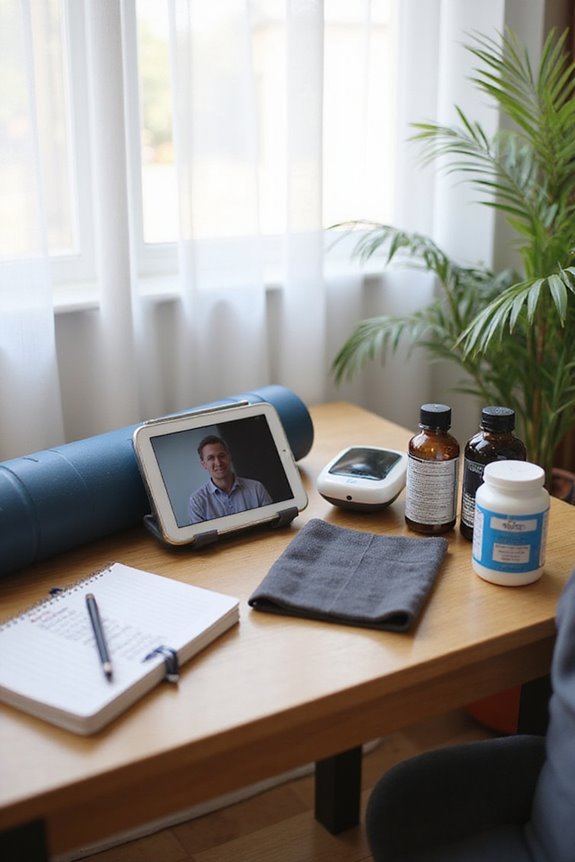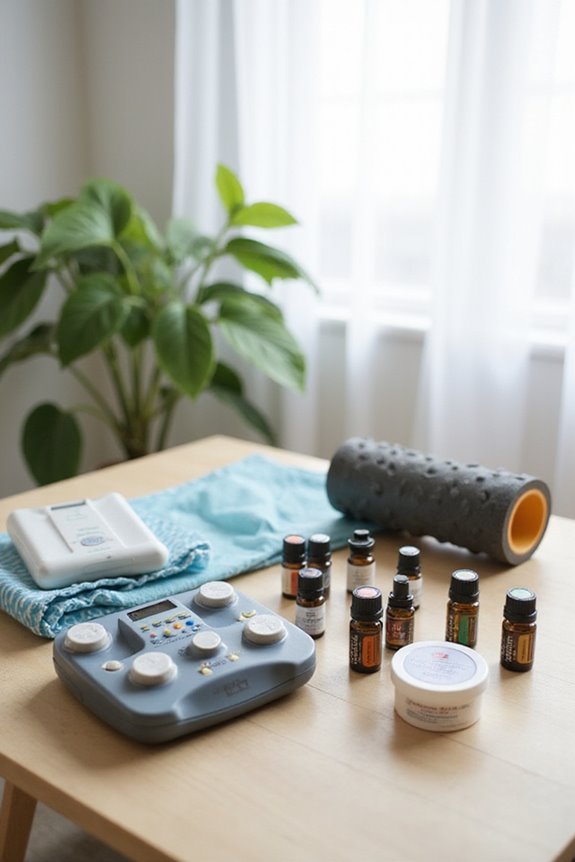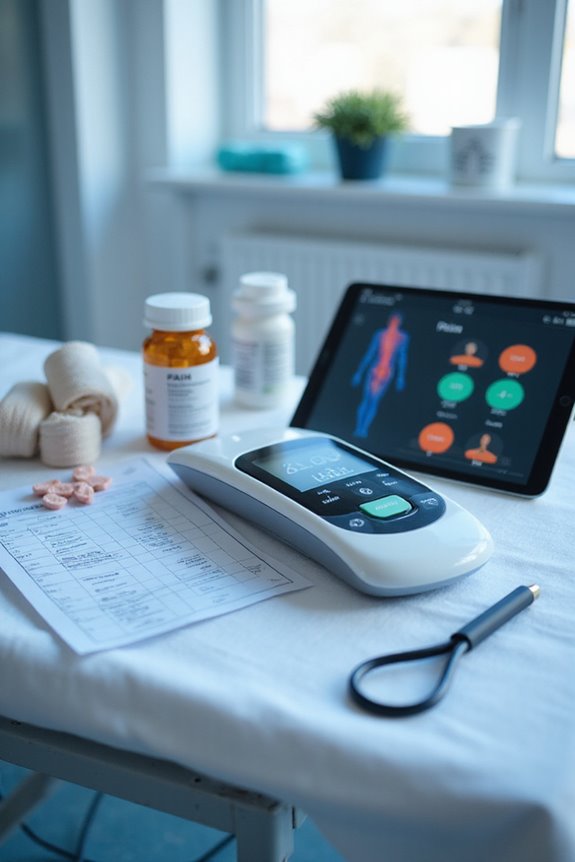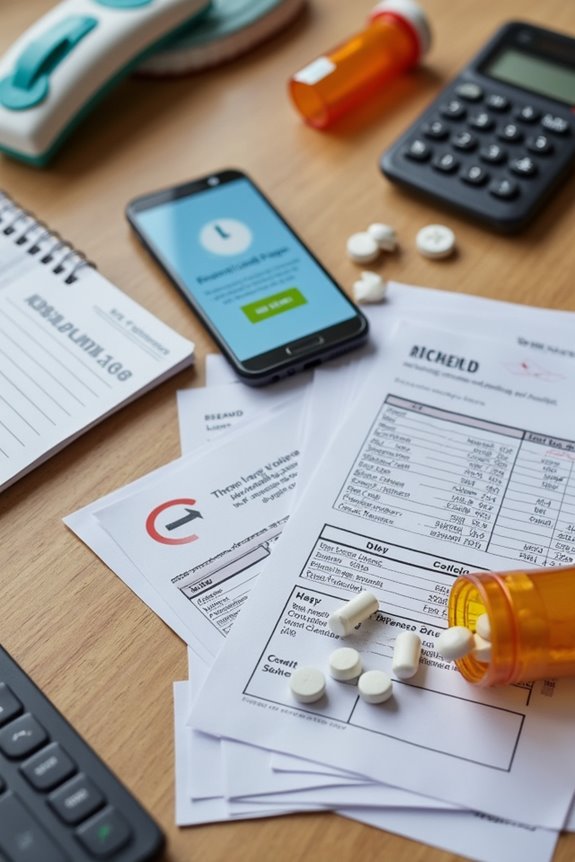Pain management tools can effectively reduce healthcare costs through improved patient outcomes. Approximately 100 million adults suffer from chronic pain, driving annual costs between $560 billion and $635 billion. Effective pain management decreases reliance on medications and hospital visits, leading to a 69% reduction in healthcare utilization post-intervention. Additionally, targeted therapies improve quality of care and lower psychological stresses. Understanding these strategies fosters informed decisions. Further insights on this topic will be explored.
Key Takeaways
- Effective pain management tools can significantly lower healthcare costs by reducing the need for expensive treatments and hospitalizations.
- Targeted therapies and physical therapy enhance pain reduction, improving quality of life and decreasing overall healthcare utilization.
- Enrollment in multidisciplinary pain management programs results in fewer clinic visits and reduced healthcare expenditures for chronic pain patients.
- Non-opioid therapies and community-based education promote cost-effective pain management solutions, minimizing reliance on costly interventions.
- Utilizing technology in pain management fosters early interventions, optimizing resources and improving outcomes, ultimately reducing healthcare costs.
The Economic Impact of Chronic Pain on Healthcare Systems
Chronic pain represents a substantial economic burden on healthcare systems, necessitating a critical examination of its impact. In the United States, approximately 100 million adults suffer from chronic pain, with annual costs ranging from $560 billion to $635 billion. This economic burden surpasses that of cardiovascular diseases, cancer, and injuries.
Key economic factors include:
- Direct healthcare costs: Estimated between $261 billion to $300 billion annually, covering treatments and hospitalizations.
- Indirect costs: Over $335 billion annually due to lost productivity, absenteeism, and presenteeism.
- Disparities: Social and racial inequalities contribute considerably to increased expenses, with excess medical expenditures estimated at $229 billion.
The overall economic impact underscores the urgent need for effective pain management strategies to alleviate this burden. Incorporating tools like TENS units can provide drug-free pain relief, potentially reducing both direct and indirect costs associated with chronic pain.
Understanding the Cost of Pain Management

Understanding the financial implications of pain management is critical, particularly given the staggering economic burden associated with chronic conditions.
Pain Management Costs
- In the U.S., annual pharmaceutical expenditures for pain management reached $16.4 billion in 2011.
- Lumbar surgeries alone incur costs of approximately $2.9 billion annually.
Chronic Pain Economics
- Total healthcare costs attributable to chronic pain are estimated between $344 billion and $395 billion.
- Approximately 80% of chronic pain costs arise from productivity losses, which considerably affect GDP.
Trends in Healthcare Utilization
- Increased healthcare resource use by chronic pain patients drives up costs.
- Ongoing monitoring and repeated treatments sustain long-term expenditures.
- Many patients seek drug-free pain relief options, such as TENS units, to manage costs effectively.
Understanding these factors is essential for addressing the challenges of pain management in healthcare systems.
Benefits of Targeted Pain Management Techniques

How do targeted pain management techniques influence healthcare costs and patient outcomes? Targeted therapies, including multimodal approaches, markedly enhance pain reduction and improve patient quality of life. By integrating pharmacologic, physical, and psychological strategies, these methods reduce treatment duration and lower overall costs.
- Functional Improvements: Physical therapy aids in functional recovery, decreasing dependence on expensive medications.
- Reduced Anxiety and Depression: Effective pain management mitigates psychological burdens, thereby lowering healthcare utilization.
- Minimized Opioid Use: Targeted techniques decrease opioid prescriptions, reducing costs linked to abuse and adverse effects.
- Quality of Life Enhancements: Improved pain management fosters adherence to treatment plans, preventing escalation of care and associated expenses.
- Convenient Solutions: The availability of portable back massagers offers individuals a practical way to manage pain at home or on the go, further reducing healthcare costs.
Peripheral Nerve Stimulation as a Cost-Effective Solution

Peripheral nerve stimulation (PNS) has emerged as a cost-effective solution in managing pain, offering significant reductions in healthcare utilization and expenses.
- PNS therapy has been shown to decrease outpatient doctor visits from an average of 5.7 to 4.9 per year.
- Total medical costs can be cut by approximately 50% after initiating PNS treatment.
- A notable 61% reduction in mean total outpatient costs indicates substantial cost savings in chronic pain management.
- Economic analyses reveal average savings of US$13,776 per patient within 12 months of PNS implantation.
- Additionally, PNS reduces indirect costs related to lost productivity and disability.
These findings position PNS therapy as a viable economic strategy within the continuum of pain management care, supporting both patient health and financial sustainability.
Interventional Pain Management vs. Surgical Options

What distinguishes interventional pain management (IPM) from traditional surgical options in the treatment of chronic pain?
- Cost Efficiency: IPM patients incur lower risk-adjusted total costs, with 36% showing reduced inpatient stays (40% vs. 43%) and post-acute care (29% vs. 31%) compared to surgical patients.
- Surgical Risks: Surgical interventions carry higher risks, including infection and longer recovery times, leading to increased healthcare costs.
- Interventional Techniques: IPM employs multidisciplinary approaches that mitigate the need for invasive procedures, thereby lowering complication rates and enhancing patient tolerability.
- Long-Term Benefits: IPM offers effective pain relief and functional improvement without the morbidity associated with surgeries, supporting a shift toward more cost-effective chronic pain management solutions. Additionally, many patients find that using heating pads for pain relief can complement their IPM strategies by providing immediate comfort and reducing the need for medication.
Long-Term Effects of Pain Management on Healthcare Utilization
Long-term pain management considerably influences healthcare utilization patterns, leading to measurable reductions in various medical interactions.
- Enrollment in multidisciplinary pain management programs shows a significant decrease in hospitalizations and emergency department visits, with average clinic visits dropping from 8.03 to 4.45 annually.
- Approximately 69% of patients report lower healthcare utilization after intervention, indicating broad effectiveness.
- Total healthcare utilization scores decline from 8.0 to 4.81 visits per year, improving patient outcomes and enhancing healthcare accessibility.
- Chronic pain often escalates healthcare demand due to related comorbidities, but effective pain management can mitigate these effects.
- By controlling pain levels, long-term management strategies lower the financial burden on healthcare systems while improving overall patient health and well-being.
System-Level Advantages of Effective Pain Management
System-Level Advantages of Effective Pain Management****
Effective pain management serves as a pivotal component in enhancing system-level efficiencies within healthcare organizations.
- Reduced Hospital Length of Stay: Effective pain control minimizes resource utilization, leading to shorter hospital stays and decreased complications.
- Decreased Hospital Readmissions: Proper pain management reduces readmission rates, benefiting financial and operational aspects of healthcare institutions.
- Enhanced Patient Satisfaction: High-quality pain management improves patient perceptions and satisfaction scores, positively impacting hospital ratings.
- Multidisciplinary Teams: Establishing specialized teams promotes holistic, patient-centered care, optimizing resource use and minimizing unnecessary interventions.
- Improved Functional Outcomes: Effective pain management enhances patient function and quality of life, supporting quicker recovery and reducing long-term healthcare dependency. Additionally, the use of heating pads can provide effective relief for various pain types, contributing to overall pain management strategies.
These advantages collectively contribute to a more efficient healthcare system, yielding both financial and qualitative benefits.
Policy Implications for Pain Management Investment
The significance of effective pain management extends beyond individual patient care, influencing broader policy considerations that shape healthcare investment strategies.
Policy Drivers
- Shift towards outpatient pain management necessitates supportive policy frameworks.
- Extensive pain programs enhance quality of care, especially in skilled nursing facilities (SNFs).
Investment Incentives
- Value-based purchasing programs align hospital reimbursements with pain management effectiveness, promoting financial support for pain initiatives.
- Regulatory actions address costs linked to inadequate pain control, motivating investment in quality care.
Economic Impact
- Effective pain management reduces hospital stays and prevents readmissions, leading to significant cost savings.
- Improved patient outcomes through investment translate to higher revenue via CMS incentives, reinforcing the economic rationale for strategic pain management policies. Additionally, incorporating natural extracts for pain relief in treatment options can further enhance patient satisfaction and reduce overall costs.
Future Directions for Cost-Effective Pain Management Strategies
As healthcare systems evolve, future directions for cost-effective pain management strategies are increasingly essential. Community education plays a pivotal role in fostering early interventions that can prevent chronic pain progression.
- Community-based models integrate pain services within local health systems, reducing emergency visits and hospitalizations.
- Trained community health workers can provide basic pain management education, decreasing reliance on specialists.
Technology integration further enhances these strategies.
- Legislation, such as the 2025 NOPAIN Act, promotes non-opioid therapies, improving access and reducing costs associated with opioid-related complications.
- Nonpharmacologic therapies, including exercise programs and mindfulness practices, are effective in minimizing costly interventions while enhancing patient participation.
Collectively, these approaches promise to optimize resources and improve pain management outcomes.
Frequently Asked Questions
What Are the Most Common Types of Pain Management Tools Available?
Pain management tools prominently feature medication options like NSAIDs and opioids, alongside physical therapy techniques such as TENS and acupuncture. This diverse array fosters a sense of community, empowering individuals to collectively navigate their pain journeys.
How Does Chronic Pain Affect Mental Health and Well-Being?
Chronic pain greatly impacts mental health and emotional well-being, often leading to anxiety and depression. Effective coping strategies, including integrated care approaches, are essential for addressing the intertwined challenges of chronic pain and mental health.
Are There Specific Demographics More Affected by Chronic Pain?
Chronic pain disproportionately affects specific demographics, particularly older age groups and those with lower socioeconomic status. Women and racial minorities also experience higher prevalence and severity, highlighting the importance of tailored approaches in pain management and support.
What Role Do Lifestyle Changes Play in Pain Management?
Lifestyle changes play an essential role in pain management, with dietary adjustments and exercise routines markedly improving pain outcomes. These modifications enhance physical function and emotional well-being, fostering a supportive community for individuals seeking relief from chronic pain.
How Can Patients Advocate for Better Pain Management Options?
Patients can advocate for better pain management options through patient education and advocacy strategies, promoting individualized care, engaging in shared decision-making, and collaborating with healthcare providers to address barriers and guarantee equitable treatment for all.





